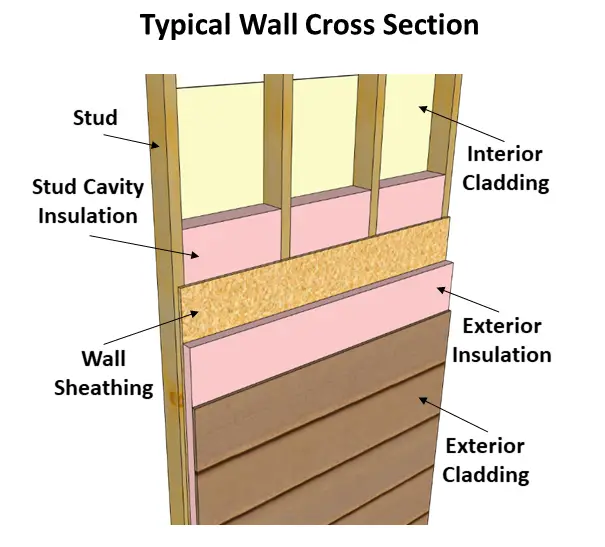This wall R-value calculator will estimate the total effective R-value for any wood stud framed wall.

Assumptions:
-
- The wall is framed with wood 2x4s or 2x6s
- No double stud or staggered studs
Notes:
-
- R-values are based on industry averages from inspectapedia.com, ahfc.us, and coloradoenergy.org
- This calculator should only be used as an estimation tool
WALL R VALUE CALCULATOR
How To Use This Calculator
First, enter the stud spacing for your wall. Typically, this is either 16″ or 24″ on center. Check out the framing calculator if you need to calculate materials for wood stud framed walls. If your wall is built with advanced framing techniques, choose either the 16″ or 24″ advanced framing option.
Next , pick your stud size. Most commonly this is either 2×4 (3.5″ width) or 2×6 (5.5″ width).
Exterior cladding is a fancy term for siding. Typical siding choices for many homes built today are vinyl or wood siding. Note there is also an option for metal/vinyl siding that comes backed with a layer of insulation.
Next, choose your exterior insulation, if applicable. Many modern homes have a continuous layer of rigid insulation wrapping the home to help minimize thermal bridging through studs.
Choose your wall sheathing next. Typically, a continuous layer of plywood sheathing is used to prevent racking and to add rigidity to stud-framed structures.
Next, pick your stud cavity insulation. The stud cavity insulation is the most important insulation component of any wall. Many homes still use fiberglass batts or blown in insulation between studs.
Finally, choose your interior cladding or wall covering. This is typically drywall or wood paneling.
Hit “calculate” to see the effective R-value of your wall.
Wall R-Value Tips
Air Film
An R-value of 0.21 for an exterior air film and 0.68 for an interior air film is added in to the calculation. These R-values account for the microscopic layers of “air insulation” that form on the interior and exterior finishes of walls.
Framing Factor
The insulation value of the wood studs is also taken into account in this calculator. A stud wall with wider spacing (i.e. 24″ on center) will have better insulating properties than a stud wall with narrower spacing (i.e. 16″ on center). This is because wider spaced stud walls have fewer studs overall. This, in turn, leaves more room for the superior insulating qualities of stud cavity insulation. This “framing factor” is taken into account and adjusts the effective wall R-value accordingly.
Effective Wall R-Value Equation
The equation used in this calculator for wall R-value is as follows:
Effective Wall R-Value = (1/(FF/(Rstud) + (1-FF)/(Rcavity.insulation))) + Rexterior.air.film + Rsiding + Rexterior.insulation + Rsheathing + Rinterior.cladding + Rinterior.air.film
where FF stands for Framing Factor.
U-Value vs R-Value
You may come across U-values (a measure of heat transfer) when researching R-values (a measure of heat resistance) of a given material. The U-value is simply the reciprocal of a given R-value. For example, soft pine wood studs typically have an R-value per inch of 1.25. This means the U-value per inch would be 1/1.25 = 0.8.
In summary, you can calculate the effective R-value of a wall assembly by taking the sum of the individual R-values of each “layer” of the wall and adjusting it by a framing factor. This framing factor is dependent on how the wall studs are laid out.
